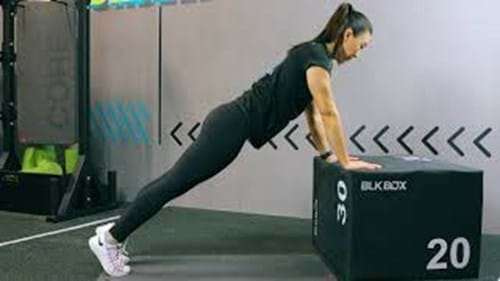Incline Push Ups
What Is An Incline Push Up?

Incline press ups, also referred to as incline push ups or elevated push ups, are a variation of standard push ups, an exercise that targets the upper body and core.
The arms are raised on an elevated surface, such as a bench, chair or step. This means that, while incline press ups are considered easier than their traditional alternatives, they're a great way to build strength, and progression is as simple as dropping to a lower elevation level.
Incline press ups primarily target the chest (pectoralis major), shoulders (deltoids), triceps (triceps brachii) and core (abdominals and obliques), while also engaging other stabilising muscles like the back, muscles and even legs.
If incline press ups aren't for you, you could also try knee push ups, which take the pressure off your muscles and joints by supporting your lower body. Other, more challenging variations include the standard press up, as well as harder alternatives like medicine ball push ups, diamond push ups, uppike push ups, one arm push ups and archer push ups.
Check out our other push up exercises: tricep push ups, push ups, wide grip push ups, decline push ups, medicine ball push ups
Commonly Asked Questions On Incline Press Ups
The angle you choose for your incline depends on a few factors - the height of the surface you actually have available (if you only have one option then that’s the best one to use!), your skill level and your goals. The higher the angle, the easier the movement is considered to be, so if you’re just starting out, you can stick to a higher elevation. Plus, different angles also work different muscles - a higher angle (like a wall push up) places more emphasis on the lower chest muscles, a moderate angle (around 45 degrees) is good for overall chest development and lower angles (closer to horizontal) will target the lower chest muscles, as well as requiring more effort from the chest and triceps.
By raising your upper body on an elevated surface for a press up, the amount of weight you need to lift is reduced and your muscles don’t need to work as hard. This makes this variation ideal for beginners, or if you have injuries or limitations that mean you can’t do traditional push ups. Incline push ups are also flexible - you can simply try different heights and angles until you find one that’s manageable, and then you can gradually reduce the gradient to progress.
Yes, incline press ups are an effective exercise for building muscle, especially in the chest, shoulders and triceps. They’re a compound exercise, so they’re great for targeting multiple muscle groups at once, and can easily be adjusted for progressive overload; you can simply lower the angle of the incline to make the push up more challenging.
Whether incline push ups or standard flat push ups are better depends on your goals and fitness level. Both options have their advantages, so you can choose based on your preference and ability. Inclined is generally considered to be better for beginners or anyone who struggles with regular press ups, while the flat version provides a bigger challenge, offering greater muscle activation and overall strength improvement.
You don't need to do incline push ups every day - two to three times a week is enough to see progress. If you’re a beginner, it’s best to start with a number that feels manageable but challenging. This could be around 5 to 10 incline push ups, building up the number of reps and sets as you build strength. However, if you’re looking to build muscle endurance and fitness, focus on a higher number of reps per set (10, 20 or more) and if your goal is to increase muscle strength and growth, aim for a lower rep range (6 to 12 reps per set), reducing the incline as you progress.
Incline Push Up Tips
A good option for beginners, especially if you're working out at home, is to use a staircase for your incline reps - find the stair level that fits your ability and, as you progress, you can simply drop a step lower until you're ready for traditional press ups.
Make sure to move in a smooth and controlled motion throughout the exercise.
Avoid arching your back or allowing your hips to sag - your body needs to be in a straight line with your core engaged throughout.
How To Do An Incline Push Up
Start in a high plank position with your hands placed on top of your chosen elevated surface (e.g. a workout bench, worktop, stairs or step). Your arms should be fully extended with a soft bend in the elbows, core engaged, and body in a straight line from head to ankles.
Place each hand as wide as is comfortable. The wider apart your hands are, the harder your chest muscles will be working. Your shoulders should be positioned above your wrists.
Keeping your body in a straight line, your arms tucked close to your body and your core engaged, bend your elbows to lower your chest towards the elevated surface.
Pause for a brief moment, before pushing through your palms to raise your body back up to the starting position.
If you’re not sure if any of the above exercises are suitable for you, please consult your doctor before you start it. Need guidance on how to perform the exercise? Ask a personal trainer at your gym.